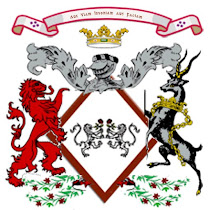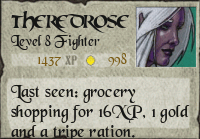
Spring is here! For many of us, this means a relief from the cold, dark days and snows of winter. As the days lengthen and get warmer, we are greeted by the rebirth of the earth itself: bulbs come up and bloom, filling the air with their heady, tempting fragrance; birds chirp and sing as they return from their winter migrations to build their nests; cats yowl out their urgent readiness for motherhood. All around us are symbols of fertility, growth, warmth and light.
Please join us in Loch Avie on April 30th for the Beltane Festival beginning at 7:00pm SLT
- Gathering 7:00-7:10pm SLT
- Recognition of the Knights of the Order of the Red Rose (knighted at last Beltane)
- Recognition of the Court of Loch Avie
- Lighting of the Beltane Fires - Ceremony in the Standing Stones
- Music
- Maypoles
- Gifts of light to take back to your own dark hearths
- Dancing
- A few surprises....perhaps traveling through time
- Places to be alone with your God or Goddess to celebrate the fertility and the renewal of life.
Historic Beltane
Beltane is an old Celtic Fire Ritual which celebrates, at the most fundamental level, the end of winter and the beginning of the warmer, lighter half of the year. It is the counterpart to Samhain, which marks the Pagan New Year and celebrates ancestors and the death of the crops (harvest). Beltane celebrates life. For the Celts, it was a festival that insured fertility and growth.
Beltane is one of the four major Sabbats in the Celtic tradition, the other three being Lammas, Samhain and Imbolc. Beltane's traditional date, May 1st, was chosen as the midway point between the vernal equinox and summer solstice (two of the four minor Sabbats).
It is believed that Beltane is a Celtic reinvention of an even older Roman festival, Floralia, which celebrated the goddess Flora and the flowering of spring. Most major religions have a holiday that marks the coming of spring. The Christian religion celebrates rebirth (or resurrection) on Easter; Easter eggs, Easter bunnies, chicks, and lilies are all pagan symbols of fertility associated with spring, adapted to the Christian tradition. The Hindu religion celebrates Holi, a carnival-like spring festival, dedicated to Krishna or Kama, the God of Pleasure. This festival resembles Beltane, with bonfires being a main focus of the holiday.

Traditionally, Beltane festivities began days before May 1st or "May Day," when villagers traveled into the woods to gather the nine sacred woods needed to build the Beltane bonfires. The tradition of "May Boughing" or "May Birching" involved young men fastening garlands of greens and flowers on the windows and doors of their prospective ladyloves before the fires are lit Beltane night. As with many Celtic customs, the type of flowers or branches used carried symbolic meaning, and much negotiating and courting could be worked out ahead of time.
Many communities elected a virgin as their "May Queen" to lead marches or songs. To the Celts, she represented the virgin goddess on the eve of her transition from Maiden to Mother. Depending on the time and place, the consort might be named "Jack-in-the-Green" or "Green Man," "May Groom" or "May King." The union of the Queen and her consort symbolized the fertility and rebirth of the world.
Because the Celtic day started and ended at sundown, the Beltane celebration would begin at sundown on April 30th. After extinguishing all hearth fires in the village, two Beltane fires were lit on hilltops. The villagers would drive their livestock between the fires three times, to cleanse them and insure their fertility in the coming summer, and then put them to summer pasture. Then the human part of the fertility ritual would begin.
As dancing around the bonfires continued through the night, customary standards of social behavior were relaxed. It was expected that young couples would sneak off into a ditch, the woods or, better yet, a recently plowed field for a little testing of the fertility waters. Even after hand-fasting was replaced by the Christian tradition of monogamous marriage, the Beltane ritual continued with a new tradition: all marriage vows were temporarily suspended for the festival of Beltane. Many a priest would lament the number of virgins despoiled on this one night, but the tradition persevered. Babies born from a Beltane union were thought to be blessed by the Goddess herself.
Beltane, like Samhain, is a time when the veil between the worlds is thought to be thin, a time when magic is possible. Whereas Samhain revelers must look out for wandering souls of the dead, Beltane merrymakers must watch for Fairies. Beltane is the night when the queen of the fairies will ride out on her white steed to entice humans away to Faeryland.
The maypole, which was either a permanent feature or cut in a ceremony during the gathering of the nine sacred woods, was a symbolic union of the God and Goddess. The maypole itself represented the male, a phallus thrust into mother earth, while the ribbons that were wound around it represent the enveloping nature of the woman and her womb. The maypole was usually danced after sunrise, when disheveled men and women would stagger back into town carrying flowers they picked in the forests or fields. The area around the maypole was decorated with the flowers, and then the winding of the ribbons would begin.

from: Welcome in the May by Annwn
We were there last night when the dark drew down:
we set the bonfires leaping.
Then we vanished in the heather
and we couldn't be found until the dawn came creeping.
Did it get a little warm around the fire last night?
Were the flames a little higher than they had the right?
Was your breath a little heavy and your dress a little tight
and the moon too bright for sleeping?



0 comments:
Post a Comment